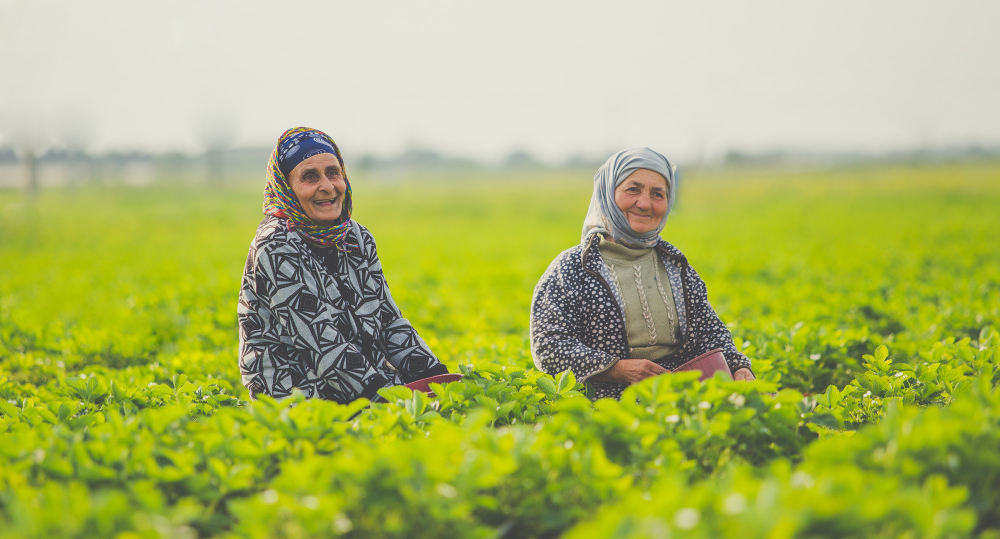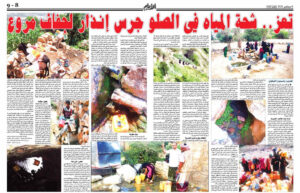Written by: Reem bin Khalifa
Climate change and conflict are two of the most prominent challenges facing the global environment today, as both share a profound negative impact on ecosystems and natural resources.
Climate changes are defined as long-term changes that result mainly from human activities, such as emissions, greenhouse gases, and pollution due to industrial activities, for example. These changes result in phenomena such as drought, floods, and sea level rise, which harms biodiversity and threatens food and water security. On the other hand, armed conflicts contribute to the destruction of the environment through water and soil pollution, the destruction of forests and infrastructure, efforts to preserve the environment and achieve sustainable development goals such as eliminating poverty, hunger and gender equality.
Climate change also exacerbates the gap of disparities, including gender disparity, which is mainly due to development models in poor societies that lack national adaptation methods and plans and the ability to find effective solutions. In the midst of this, women suffer from violence, hunger and diseases, so it is important to understand A gender approach is a crucial step in integrating genders and engaging women as agents of change and combating climate change.
The case of Sudan: a vivid example of women’s suffering
In countries like Sudan, which suffer from conflicts, climate change, and environmental genocide, painful scenes of human suffering appear clearly on television and telephone screens, and World Health Organization reports monitor this, with the spread of hunger and diseases due to the accumulation of waste, lack of health care, and others.
Sudan is considered one of the countries most vulnerable to climate change, as it is witnessing high temperatures, irregular seasonal rainfall, long periods of drought, and frequent floods. These threats lead to exacerbation of sexual health problems, such as decreased sexual desire and reduced hormonal production, while deficiency leads to Water, malnutrition and hunger increase problems with sexuality and fertility.
Women and girls face increased vulnerabilities to all forms of gender-based violence, including conflict-related sexual violence, human trafficking, child marriage, and other forms of violence.
Like conflicts, disasters associated with these changes, such as floods and drought, lead to the displacement of many families and their loss of their sources of livelihood. Women in such situations are also more vulnerable to poverty, homelessness and sexual exploitation. According to United Nations estimates in 2018, 80% of those displaced due to... Climate Change Be Women (Aguilar, L. (2009
Climate changes also increase incidents of sexual slavery and underage marriage, which is often done as an attempt to get rid of the burden of girls in light of the decline in the incomes of poor and agricultural families. Furthermore, these disasters make it difficult for girls to access health care, social services, and community support, but during disasters, sanitary pads can become scarce or expensive. The lack of availability of these products can result in serious health and psychological problems, as during the 2015 Nepal earthquake. For example, women in the affected areas faced great difficulty in obtaining sanitary pads, as many of them were forced to use alternative and unhealthy materials, which led to the spread of infections and diseases.
An additional burden on women in securing resources
Agriculture is the most important sector of employment for women in low-income and lower-middle-income countries. During periods of drought and irregular rainfall, women are forced to exert greater effort at work to secure income and resources for their families, which places additional pressures on girls who are often forced to give up About studying to help their mothers bear the increasing burden.
The “Climate Injustice” report issued by the Food and Agriculture Organization of the United Nations last March stated that climate change disproportionately affects the incomes of rural women, people living in poverty, and the elderly population, as they do not have the same ability to respond to and adapt to extreme climate events.
The report indicates that women heads of households in rural areas located in low- and middle-income countries suffer much greater financial losses every year than their male counterparts.
Female-headed households lose, on average, 8% of their income due to heat stress and an additional 3% due to floods, compared to male-headed households. This is demonstrated by a US$83 per capita reduction due to heat stress and a US$35 reduction due to floods, bringing the total decline to US$37 billion and US$16 billion, respectively, across all low- and middle-income countries.
School dropout and low academic achievement
Low income, malnutrition, and inequality due to the intersection of conflict and climate change affect educational attainment and academic performance, as rates of absenteeism from school increase among girls who have been exposed to climate shocks or due to fear, insecurity, and the destruction of infrastructure, while others are forced to drop out of school.
In regions such as Somalia and Ethiopia, recurring drought and water scarcity have reduced agricultural production, forcing families to rely on girls to fetch water from long distances or work in the fields instead of going to school.
In Malawi, floods destroyed schools and homes, making continued education for girls difficult due to deteriorating infrastructure and the need to rebuild communities. Also, in Nigeria, rates of child marriage are increasing as a means of alleviating the economic burdens resulting from agricultural crop losses linked to climate change, leading to girls dropping out of education at an early age.
Malnutrition and diseases
Climate change also contributes to food insecurity, which raises rates of malnutrition and leads to diseases such as anemia in adolescent girls. According to the UNICEF report, “Adolescent girls and women suffer from undernourishment and neglect... a global nutrition crisis.” The countries concerned with malnutrition are Ethiopia and Afghanistan. Burkina Faso, Chad, South Sudan, Sudan, Somalia, Kenya, Mali, Niger, Nigeria and Yemen. He stressed that persistent inequality is deepening the nutrition crisis among adolescent girls and women. The number of adolescent girls, pregnant and lactating women suffering from severe malnutrition has risen sharply from 5.5 to 6.9 million, or by 25%, since 2020 in 12 countries that have borne the worst impacts of the global food and nutrition crisis.
Combined with violence, malnutrition and disease during natural disasters, women are less likely to survive and more likely to be injured or die due to gender disparities that create disparities in knowledge, ability to move around, make decisions, and access to resources and training.
Building environmental peace
To withstand and adapt to climate change, countries that live at the intersection of this destructive duality, such as Sudan, need resources to repair infrastructure and ensure the ability of health care, food, water, and energy systems to withstand extreme climate phenomena.
It also needs to take proactive measures and measures to enhance environmental peace building and develop an early warning system within the framework of climate adaptation strategies in general. In particular, it is necessary to promote gender equality in the field of climate change in several aspects, such as providing training and awareness for women and men about the effects of climate change. And ways in which we can contribute to mitigating these impacts, and ensuring that the technology and innovations needed to implement climate change solutions are available to everyone, including women and girls in low-income communities.
Measures also include directing funding and resources equitably to both genders, achieving equal access to opportunities and empowering women with regard to resources concerned with mitigating the effects of climate change, such as the green and blue transition through the adoption of sustainable agriculture and clean energies.
Public policies and programs must take into account the special needs of women and girls, especially with regard to the economic and social impacts of climate change.
The image is taken from: Freepik





